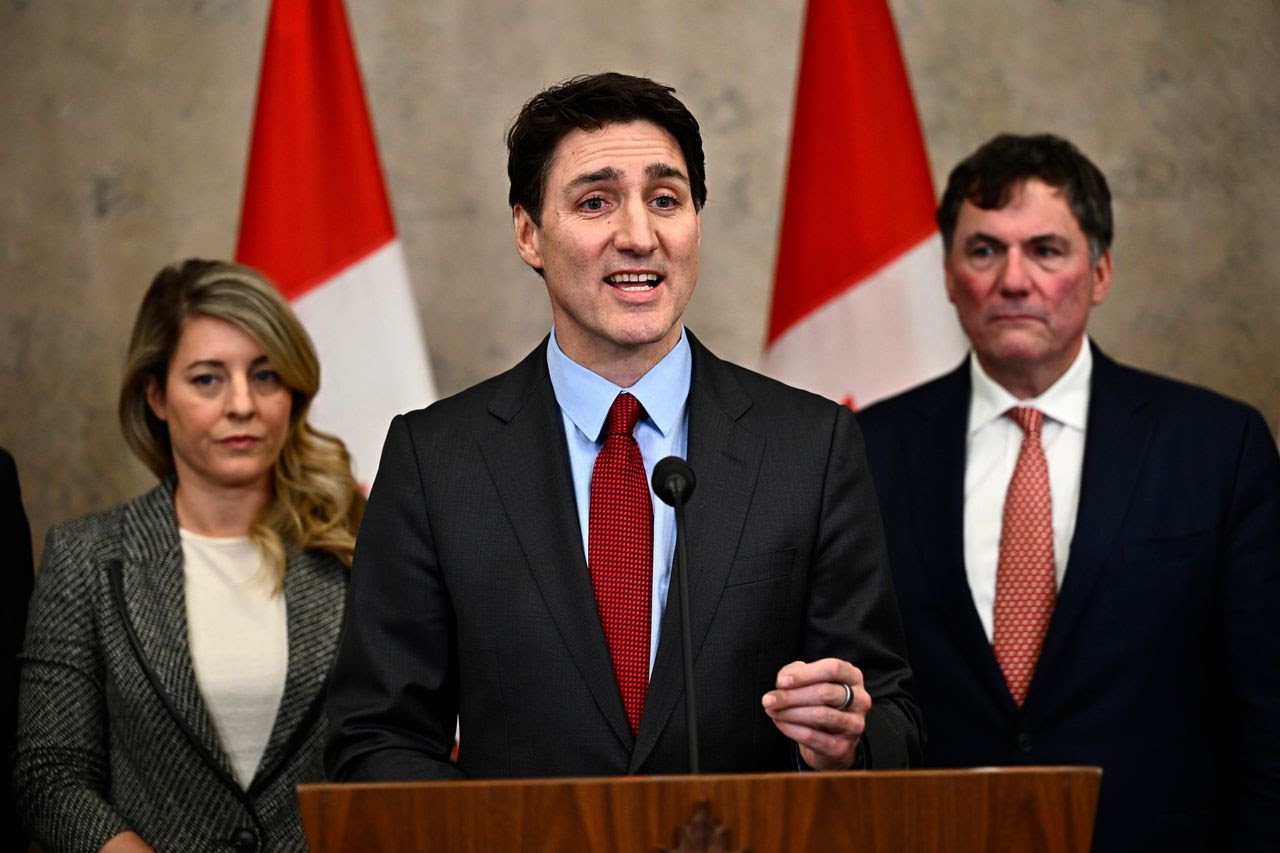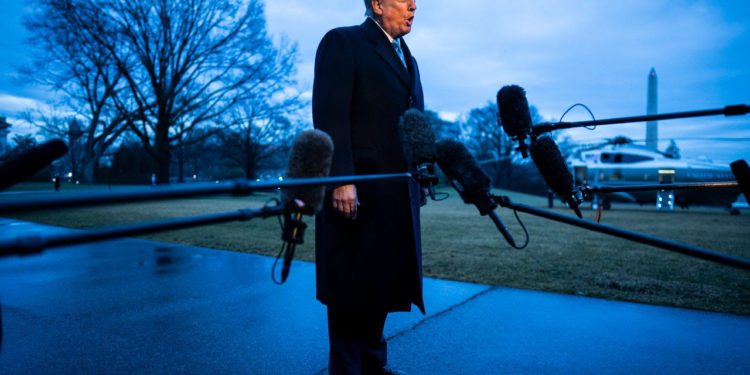By Ishaan Tharoor
with Sammy Westfall
The “America First” rubber is hitting the road. After months of threats by President Donald Trump, his administration formally imposed tariffs on imports from Canada and Mexico, as well as an additional tax on Chinese goods — the United States’ three biggest trade partners. The move is in keeping with Trump’s avowed nationalist agenda and the protectionist promises he has made to voters. But his decision to start his second term by launching a potentially damaging trade war on the United States’ two big neighbors has baffled economic analysts and infuriated officials to the north and south.
“Effective Tuesday at 12:01 a.m. Eastern time, American importers will pay a new 25 percent tax on goods from Canada and Mexico and a 10 percent levy on products from China,” my colleagues reported. “Most products from Canada and Mexico currently face no tariffs, under a trade deal Trump signed during his first term, while many Chinese goods incur taxes of up to 25 percent. The new tariffs are in addition to those fees.”
Trump casts the measures as punitive action to compel all three countries to do more to crack down on the passage of undocumented migrants and illicit drugs — in particular, Chinese-linked fentanyl — into the United States. But he has also harbored long-standing gripes over U.S. trade deficits with these countries and believes that further tariffs incentivize companies to relocate manufacturing operations and other elements of their businesses to the United States. He argued Sunday that whatever pain Americans may feel as a result of the tariffs will be “worth the price.”
Never mind the myriad studies that show such tariffs spiking inflation in the United States and impacting the U.S. consumer — to the tune of $1,200 in lost purchasing power, per one estimate. Never mind the complexity of the deeply intertwined economies of North America, where goods and parts traverse borders multiple times amid sprawling global supply chains. And never mind the trade deal that Trump himself negotiated with both neighbors in his first term that he is now, effectively, tearing up.
The potential longer-term implications run deep: The announced steps “would bring the average US tariffs rate back to levels seen in the 1940s,” noted Nicolás Saldías, a senior analyst in the Economist Intelligence Unit. “This would effectively reverse decades of trade agreements to reduce tariffs. Globalization is over.”

The reaction from the United States’ neighbors has been swift and angry. In Ottawa, hockey fans booed the U.S. anthem during a weekend NHL game. Canada’s government, meanwhile, had already prepared tit-for-tat retaliatory tariffs and other steps in response to the across-the-board levies imposed by the United States. “We’re certainly not looking to escalate,” Canadian Prime Minister Justin Trudeau said in an address to the nation Saturday that didn’t hide the sense of betrayal and shock many Canadians feel about Trump’s moves. “But we will stand up for Canada, for Canadians and for Canadian jobs.”
Just 1.5 percent of migrants apprehended by U.S. Customs and Border Protection, and 0.2 percent of fentanyl seized at U.S. borders, came from Canada in the 2024 fiscal year. Nevertheless, Canada mustered a $900 million funding plan for additional border security to assuage Trump’s concerns. That didn’t sufficiently appease the White House, and now Canadians find themselves facing a Trump-provoked economic disaster.
“Canada sends nearly 80 percent of its exports to the United States, and millions of Canadian jobs are tied to that trade,” wrote my colleague Amanda Coletta. “Economists project that tariffs of25 percent …could tip the Canadian economy into a recession, shrinking gross domestic product by 2.6 percent.”
Canadian officials recognize the asymmetry in the relationship with the United States as the smaller partner, but also know that they, too, can inflict a degree of pain. “Canada now has no choice but to hit back and hit back hard,” said Doug Ford, the premier of Ontario, Canada’s most populous and wealthiest province. “We need to maximize our points of leverage and use them to maximum effect.”
Still, ordinary Canadians would see their currency weaken and the cost of U.S. imports soar. “It’s mutually assured destruction,” Christopher Sands, director of the Wilson Center’s Canada Institute, told Coletta.

The anguish is shared by Mexico. On Saturday, President Claudia Sheinbaum announced the initiation of the country’s “Plan B” response to Trump — its own retaliatory measures — and described the tariffs as a “flagrant violation” of existing trade agreements. She cast the White House’s allegation that her government was in cahoots with drug-trafficking cartels as “slander” and pointed the finger, again, at the U.S. gun companies whose weapons flood across the border into Mexico and the unabated hunger in U.S. society for illicit drugs.
Successive Mexican governments have cooperated with the United States in curbing illegal migration and policing drug trafficking, but such flows are impossible to fully stem. Trump is layering an economic confrontation on top of a difficult security conundrum that successive U.S. and Mexican administrations have struggled to resolve.
“If these tariffs are imposed, your consumers are going to face higher prices,” Mexico’s economy minister, Marcelo Ebrard, said on Friday, addressing Americans. “Let’s be clear: The biggest impact will fall on families in the United States, who will have to pay 25 percent more.”
But Mexico has plenty to lose: Exports to the United States form the main driver of its economy. The 25 percent tariffs, if enacted and prolonged, would tip Mexico into recession. That might also undermine the White House’s guiding argument for the tariffs. If Trump’s tactics “weaken the Mexican economy or leave the country more unstable, migration could surge and criminal activity could intensify at the border,” my colleagues reported.
Trump knows the United States has more leverage over its neighbors than they do over his country. But exploiting that position of strength could cause a historic rupture. “The U.S. willingness to ignore its treaty obligations, even with friends, won’t make other countries eager to do deals,” noted the right-wing Wall Street Journal editorial board. “Maybe Mr. Trump will claim victory and pull back if he wins some token concessions. But if a North American trade war persists, it will qualify as one of the dumbest in history.”
Barbara Matthews, a fellow at the Atlantic Council, argued that Trump’s moves this weekend ushered in a new era where “Washington no longer considers international trade to be either benign or always beneficial.” She added that it also “tells the world that the United States’ trade treaty commitments come with a caveat: trading partners must support U.S. policy priorities.”
Such a “might-makes-right” approach to geopolitics is precisely what successive U.S. administrations have criticized about the behavior of putative rivals in China and Russia. Now, Trump has offered the strongest indication yet that he is shirking decades of alliance-building and careful multilateral diplomacy for an embrace of great-power competition.
Foreign policy savants are skeptical of its merits. “The United States’ return to nineteenth-century power politics will likely not yield the bonanza that Trump has promised,” Ivo Daalder and James Lindsay wrote in Foreign Affairs. “Until now, Washington’s network of alliances has granted the United States extraordinary influence in Europe and Asia, imposing constraints on Moscow and Beijing at a scale that neither power can replicate.”
Bullying neighbors and wildly disrupting international trade will have political consequences. “Ceding that advantage will come at great cost to the United States,” they added. “Not only will erstwhile U.S. allies no longer follow Washington’s lead, but many could also seek safety by aligning themselves more closely with Russia and China instead.”







Discussion about this post